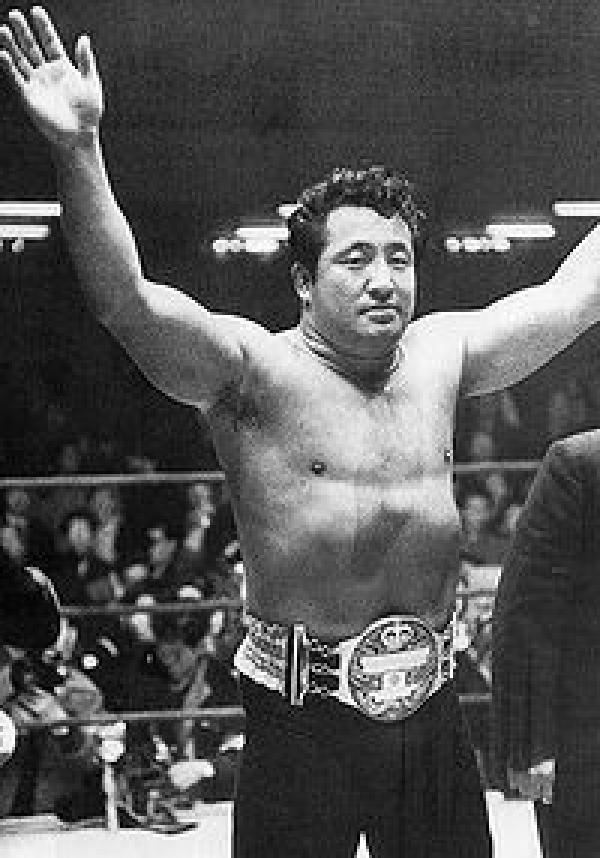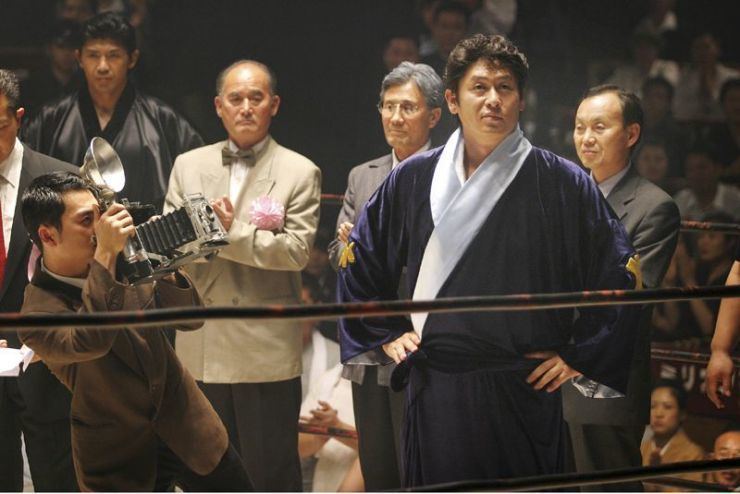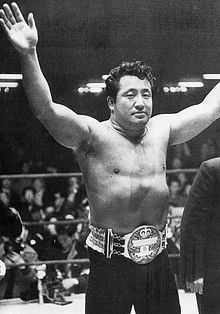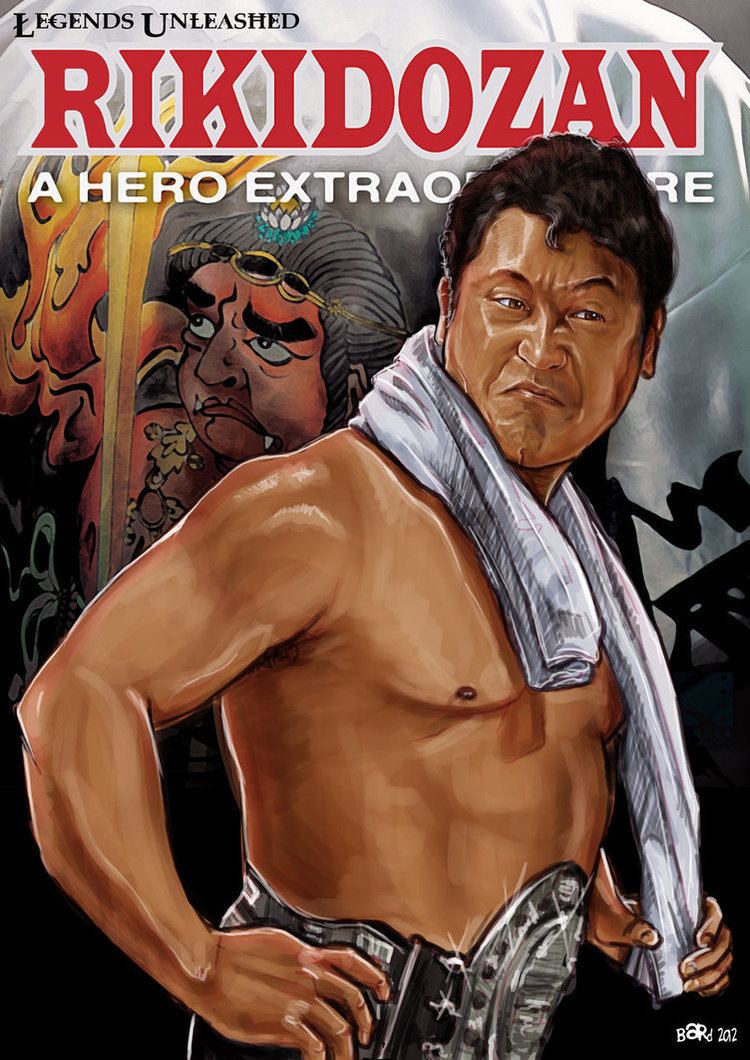Birth name Kim Sin-rak Name Mitsuhiro Momota Billed height 1.75 m (5 ft 9 in) Makuuchi rank Sekiwake | Cause of death Peritonitis Billed weight 110 kg (240 lb) Role Professional wrestler | |
 | ||
Ring name(s) RikidozanMitsuhiro Momota Stable Nishonoseki stable (until 1950) Spouse Keiko Tanaka (m. 1963–1963) Children Mitsuo Momota, Yoshihiro Momota Similar People | ||
Lou thesz versus rikidozan
Mitsuhiro Momota (Japanese: 百田 光浩, Hepburn: Momota Mitsuhiro) (born Kim Sin-rak; Hangul: 김신락; Hanja: 金信洛; November 14, 1924 – December 15, 1963), better known as Rikidōzan (力道山, Hangul: 역도산; RR: Yeokdosan), was a Korean-Japanese professional wrestler, known as the "Father of Puroresu" and one of the most influential men in professional wrestling history. Initially, he had moved from his native country Korea to mainland Japan to become a sumo wrestler. He was credited with bringing the sport of professional wrestling to Japan at a time when the Japanese needed a local hero to emulate and was lauded as a national hero. He was murdered by a member of the Yakuza in 1963.
Contents
- Lou thesz versus rikidozan
- The ballad of rikid zan and the birth of puroresu
- Early years
- Professional wrestling
- Death
- Family
- In wrestling
- Championships and accomplishments
- Sumo Top Division Record
- Legacy
- Popular culture
- References
The ballad of rikid zan and the birth of puroresu
Early years

Rikidōzan was born Kim Sin-rak in South Hamgyong, in Korea, on November 14, 1924. He became the adopted son of the farmer "Momota family" of Nagasaki Prefecture when he was young and trained to be a sumo wrestler. He joined Nishonoseki stable, and made his debut in May 1940. Due to the discrimination against Koreans by the Japanese, Sin-rak claimed that his name was Mitsuhiro Momota (Momota being the surname of the family which adopted, but later disowned, him) and listed his birthplace as Omura, Nagasaki. He was given the shikona of Rikidōzan. He reached the top makuuchi division in 1946 and was runner-up to yokozuna Haguroyama in the tournament of June 1947, losing a playoff for the championship. He fought in 23 tournaments in total, with a win-loss record of 135-82. His highest rank was sekiwake.
Professional wrestling

Rikidōzan gave up sumo in 1950. Although he claimed it was for financial reasons, discrimination against Koreans may have been a contributory factor. He made his professional wrestling debut in 1951 with a ten-minute draw against Bobby Bruns. He established himself as Japan's biggest wrestling star by defeating one American wrestler after another. This was shortly after World War II, and the Japanese needed someone who could stand up to the Americans. Rikidōzan thus became immensely popular in Japan. His American opponents assisted him by portraying themselves as villains who cheated in their matches. Rikidōzan himself was always booked as a villain when he wrestled in America.
Rikidōzan gained worldwide renown when he defeated Lou Thesz for the NWA International Heavyweight Championship on August 27, 1958 in Japan. In another match, Thesz willingly agreed to put over Rikidōzan at the expense of his own reputation. This built up mutual respect between the two wrestlers, and Rikidōzan never forgot what Thesz did. He would go on to capture several NWA titles in matches both in Japan and overseas. Rikidōzan also trained professional wrestling students, including soon-to-be wrestling legends Kanji "Antonio" Inoki, Ooki Kintaro, and Shohei "Giant" Baba.

His signature move was the karate chop, which was actually based on sumo's harite, rather than actual karate. It is rumoured that he had been coached by fellow Korean Masutatsu Oyama, but he is more likely to have been coached by another Korean karateka, Nakamura Hideo.
With his success in pro wrestling, Rikidōzan began acquiring properties such as nightclubs, hotels, condominium and boxing promotions. He established the Japan Pro Wrestling Alliance (JWA), Japan's first professional wrestling promotion, in 1953. His first major feud was against Masahiko Kimura, the famous judoka who had been invited by Rikidōzan to compete as a professional wrestler. Other famous feuds included those against Thesz in 1957-58, against Freddie Blassie in 1962, and against The Destroyer in 1963. In wrestling journalist John M. Molinaro's 2002 book Top 100 Pro Wrestlers of All Time, it is noted that two of Rikidōzan's matches are rated in the top ten television programs of all time in Japan. His October 6, 1957 sixty-minute draw with Lou Thesz for the NWA World Heavyweight Championship drew an 87.0 rating, and his May 24, 1963 sixty-minute two out of three falls draw with The Destroyer drew a 67.0 rating, but a larger viewing audience (the largest in Japanese history) than the previous match, since more people had television sets by 1963.
Death
On December 8, 1963, while partying in a Tokyo nightclub, Rikidōzan was stabbed with a urine-soaked blade by a man named Katsuji Murata who belonged to the ninkyō dantai (Yakuza) Sumiyoshi-ikka. Reportedly, Rikidōzan threw Murata out of the club and continued to party, refusing to seek medical help. Another report states that Rikidōzan did indeed see his physician shortly after the incident, and was told the wound was not serious. He died a week later of peritonitis on December 15. It is rumored by Kimura that his murder was in retaliation for when Rikidōzan attacked Kimura during a wrestling match, after Kimura delivered an errant kick to Rikidōzan's groin, ignoring a pre-match arrangement and attacking Kimura for real.
Murata served seven years in prison for manslaughter. Murata claimed that on December 15 of every year he would call up the family (Rikidōzan’s sons, Mitsuo and Yoshi Momota), apologize and then visit Rikidōzan’s grave.
Family
One of his sons, Mitsuo Momota, followed his father into the ring in 1970 and still works as a freelancer, but was never able to earn the recognition that once made his father famous, despite winning the World Junior Heavyweight Championship in 1989. Mitsuo's son, Chikara Momota, made his in-ring debut on December 16, 2013, the day after the fiftieth anniversary of the death of his grandfather. Rikidōzan's other son, Yoshihiro Momota, was also a pro wrestler.
Rikidōzan's son-in-law, Bak Myeong-cheol (박명철), has been a member of the National Defence Commission of North Korea since around early 2009, while Bak Myeong-cheol's younger sister is the vice secretary of the Light Industry Division of the Workers' Party of Korea.
In wrestling
Championships and accomplishments
Sumo Top Division Record
Legacy
Rikidōzan posthumously became one of the first members of the Wrestling Observer Newsletter Hall of Fame in 1996, and he was posthumously inducted into the Professional Wrestling Hall of Fame and Museum in 2006. In 2002, Rikidōzan was named the 3rd greatest pro wrestler of all time behind Ric Flair and rival Lou Thesz in the magazine article 100 Wrestlers of All Time by John Molinaro, edited by Dave Meltzer and Jeff Marek.
Popular culture
Rikidōzan appeared in 29 films, including:
In 2004, A South Korean film, Rikidōzan was made about the life of the wrestler, with Sol Kyung-gu playing the titular role.
